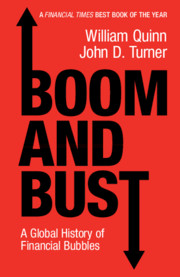Crossref Citations
This Book has been
cited by the following publications. This list is generated based on data provided by Crossref.
2021.
RRPEBooks Received: Spring 2021.
Review of Radical Political Economics,
Vol. 53,
Issue. 1,
p.
223.
Siklos, Pierre L.
2021.
Did the Great Influenza of 1918-1920 Trigger a Reversal of the First Era of Globalization?.
SSRN Electronic Journal,
Vogel, Harold L.
2021.
Financial Market Bubbles and Crashes.
p.
55.
Siklos, Pierre L.
2021.
Did the great influenza of 1918-1920 trigger a reversal of the first era of globalization?.
SSRN Electronic Journal ,
EVLİMOĞLU, Umut
and
GÜDER, Mustafa
2021.
TARİHTEKİ EKONOMİK BALONLAR IŞIĞINDA KRİPTO PARALARA GENEL BİR BAKIŞ.
Abant Sosyal Bilimler Dergisi,
Vol. 21,
Issue. 3,
p.
469.
McCartney, Sean
2022.
Managerial Failure in early Victorian Britain: Network and capital expansion during the Railway Mania.
Business History,
p.
1.
Garner-Knapp, Lindsey
Western, Shaina D.
and
Lovat, Henry
2022.
European Yearbook of International Economic Law 2021.
Vol. 12,
Issue. ,
p.
3.
Kim, Won Joong
and
Rhee, Hyok-Joo
2022.
Statistical Examination of the Spiraling House Prices in Seoul : Government versus Market.
Journal of Korea Planning Association,
Vol. 57,
Issue. 7,
p.
69.
Serrano-Gallardo, Pilar
Manzano, Ana
and
Pawson, Ray
2022.
Non-pharmaceutical interventions during COVID-19 in the UK and Spain: a rapid realist review.
Open Research Europe,
Vol. 2,
Issue. ,
p.
52.
Serrano-Gallardo, Pilar
Manzano, Ana
and
Pawson, Ray
2022.
Non-pharmaceutical interventions during COVID-19 in the UK and Spain: a rapid realist review.
Open Research Europe,
Vol. 2,
Issue. ,
p.
52.
Taffler, Richard
Bellotti, Xijuan
Agarwal, Vineet
and
Li, Linglu
2022.
Investor Emotions and the Psychodynamics of Asset Pricing Bubbles: A Chinese Perspective.
Journal of Behavioral Finance,
p.
1.
Siklos, Pierre L.
2022.
Did the great influenza of 1918–1920 trigger a reversal of the first era of globalization?*.
International Economics and Economic Policy,
Vol. 19,
Issue. 3,
p.
459.
2022.
Books Received (as of March 2022).
Review of Radical Political Economics,
Vol. 54,
Issue. 1,
p.
136.
Haykir, Ozkan
Yagli, Ibrahim
Aktekin-Gok, Emine Dilara
and
Budak, Hilal
2022.
Oil Price Explosivity and Stock Return: Do Sector and Firm Size Matter?.
SSRN Electronic Journal ,
de Jong, Abe
Kooijmans, Tim
and
Koudijs, Peter
2022.
Going for Broke: Underwriter Reputation and the Performance of Mortgage-Backed Securities.
SSRN Electronic Journal ,
Kenny, Seán
Ögren, Anders
and
Zhao, Liang
2023.
The highs and the lows: bank failures in Sweden through inflation and deflation, 1914–1926.
European Review of Economic History,
Vol. 27,
Issue. 2,
p.
223.
Baragar, Fletcher
2023.
Books Received (as of March 2023).
Review of Radical Political Economics,
Vol. 55,
Issue. 1,
p.
217.
Borowiecki, Karol Jan
Dzieliński, Michał
and
Tepper, Alexander
2023.
The great margin call: The role of leverage in the 1929 Wall Street crash.
The Economic History Review,
Vol. 76,
Issue. 3,
p.
807.
Tsaliki, Persefoni
and
Tsoulfidis, Lefteris
2023.
Financialization Historically Contemplated: Putting Old Wine in New Barrels.
World Review of Political Economy,
Vol. 14,
Issue. 3,
Bourghelle, David
2023.
Handbook of Economics and Sociology of Conventions.
p.
1.





